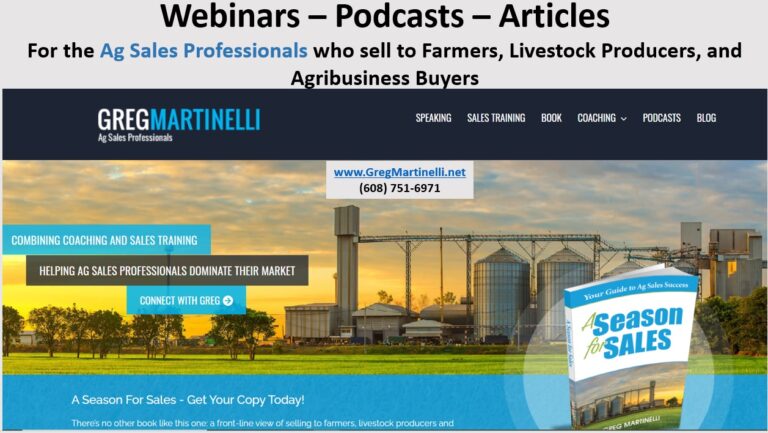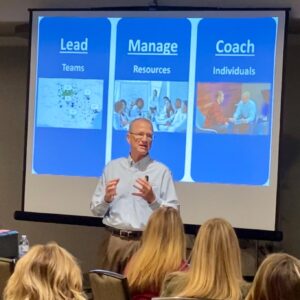What would a website of YOU look like?
One of the first steps in my sales workshop is to have attendees explain what they do, who they do it for and why customers buy from them. You would be amazed how often this drill stumps the attendees. After they struggle with it, I have them turn to a neighbor and introduce themselves using the answers to these three questions: What they do, who they do it for and why customers buy from them.
Once they awkwardly tell their neighbor that they “sell precision ag services or sell seed or sell feed to farmers” and that people buy from them because, “They care about their customers” or “They don’t just go out and push product”, I have them come back to the main group to debrief the exercise. It’s at this point that attendees realize two very important lessons from this exercise. First, the “who they sell to” or “who they do it for” is too generic. Saying you sell to “Farmers” is too generic. Which kind of farmers? Which size, type, demographics do you sell to? Which segment of farmers are you the best fit for? The second important lesson attendees realize is that everyone gave the same reasons that customers buy from them. We all sound the same. Try it with your team or on yourself today. Ask, “What do you do? Who do you do it for? And “Why do they buy from you/me?”
I then pose a thought, “If it’s this hard for you to tell your peer what you do, who you do it for and why they should buy from you, imagine how hard it is for your customer to figure it out.” Your customer or prospect is trying to understand “Why you? Why your products? Why now?” When they can’t figure it out, they resort to a form of resistance. The most common are price and complacency. Customer complacency sounds like, “I’m happy with what I’m currently doing” or, “I’ll think about it and let you know if we ever want to go with you”
The purpose of this exercise is to get salespeople to understand that customers are trying to answer one question every time a salesperson calls on them: “Why should I buy from you?” See the previous blog at Why Should I buy from You?
One technique for improving this situation with attendees is to have them sketch out a website on themselves. Our prospects think of us like a website. There’s one main picture and several tabs. Think about the vendors you do business with. Say the name of the store or business where you grocery shop, have phone service, your gym, or shopping mall. Odds are, when you said the name of that business, you imagined a picture of the store and maybe even someone who works there. Then you thought of their products, service, why you buy from them and how you feel when you go there.
Our prospects and customers think of you the same way. They have an image of you, your products and how they feel when doing business with you. On a sheet of paper, I have them sketch out a website design. They don’t need to be artists for this. The pictures are rough, in some cases extremely rough drawings. The main point is the drop-down tabs. This is where it gets challenging for them. Most people want a bunch of tabs for their various product lines and services. They also want the website to be all about their company. So, I limit them to one tab for products and one tab for services on their homepage. The rest of the website needs to give site visitors an understanding of why this individual salesperson is the best choice in their market.
Prospects can learn all about your company brand and product info from the company web page. However, it’s YOU that brings the brand to life. It’s YOU that becomes the reason customers want to do business with your company.
Sure, you need good products and services to stand behind you. That’s the ante to get in the game. But there are many competitors with good products as well. Your competitive advantage becomes YOU.
Here are two scenarios that might shed some light on how you can change your next introduction to a prospect.
Greg (salesperson): “Hi Kevin, I’m Greg. I sell supplements for ABC Agri-business. We have a great line of nutrients, with great ROI. In fact, we’re the largest, oldest nutrient company with locations all over the world. Just yesterday, we opened our fourth office in Zenocostia.”
Kevin (Greg’s farmer prospect): If he was completely transparent, might say: “That’s great Greg, but I’m terribly busy and you haven’t said one thing that tells me how you are going to help me, on my farm, today. Maybe you could help those folks in Zenecostia.
Another approach that Greg could use in our simulated scenario:
Greg: “Hi Kevin, I’m Greg. I work with producers like yourself in this area to solve problems like ABC, XYZ, and DEF… Recently, we’ve been seeing a lot of XYZ. Thought I would introduce myself today and see if we might be able to help you with your operation.”
Kevin: “Well, I can always use the help. What do you have for problems like MNO?”
Bonus Tip:
Here’s my bonus tip for Greg and for you. If you are Greg in this scenario and your prospect hands you a gift like Kevin did. That gift is a problem that you know how to solve. Fight the urge to jump in with your super-duper solution to Kevin’s problem. Instead, dig deeper and ask questions about Problem MNO. Ask to go see the problem if that makes sense. Too often, a salesperson will jump in at this point and position a product to solve the producer’s problem. Only to find out after 10 minutes of selling that the salesperson misunderstood the prospect’s real problem.
If you found this to be helpful, forward on to someone you know who might also appreciate it.





